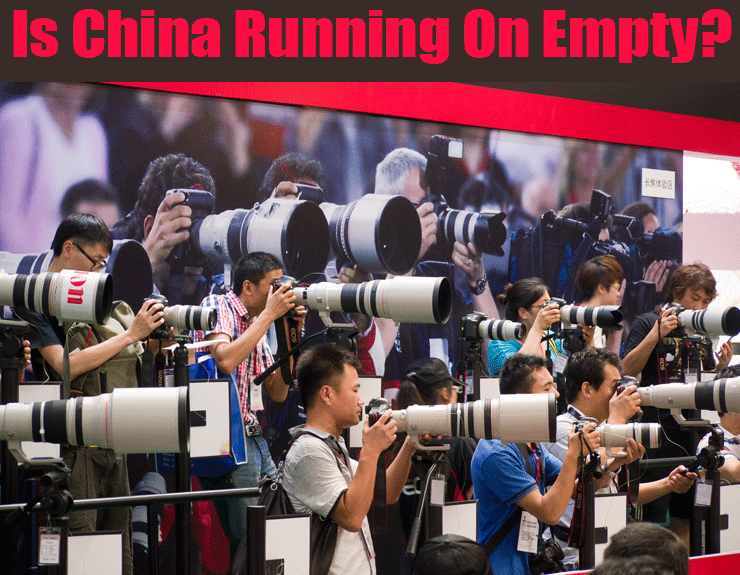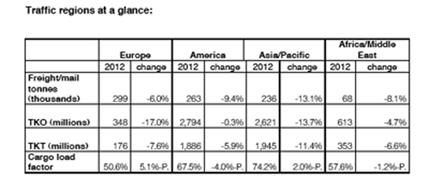
When it comes to China everybody wants the big picture:
Here visitors try out professional cameras on display at The
Photo & Imaging Show last week in Shanghai.
 China is still on pace to overtake
the United States as the world’s largest economy by
2020.
China is still on pace to overtake
the United States as the world’s largest economy by
2020.
Now, China has made some moves
to goose up the world’s second-biggest economy by cutting
interest rates for the second time in a month.
That action inspired the well-respected
USA financial publication Barron’s to write:
“To us it looks like
the Great China Growth Story may be falling apart.”
Obviously what is happening
in China is old news to air cargo, with the general slowdown
felt by all serving as testament to that.
New Yorker Online
reported this week:
“Nike says that its Chinese
stockrooms are piling up with inventory.
“Similar complaints are
coming in from McDonald’s, Caterpillar, and Procter
& Gamble Co.
“Within China, the stakes
of a slowdown are high as well: for half a century, political
scientists have recognized that political unrest does not
tend to erupt in places that are most deprived; it hits when
a pattern of rising growth and expectations abruptly stops.
“And that is Beijing’s
worst fear.”
Adding to China’s woes
is a flat real estate market, which, as construction slowed,
has impacted commodity prices for copper, steel, and other
building essentials.
China as manufacturer to the
world must now factor into its plan the overall slump in Europe
and America, and that the reality of 2012 has either left
China exports piled up, or caused manufacturing to idle down
considerably from its former mega-clip.
No doubt, the current situation
reaches out and is felt by every sector, including the nation’s
large merchant ship fleet that, without orders, must go out
and sail around looking for business, or worse—stay
stuck in port.
But all is not gloom and doom.
Recently, The Financial
Times wrote:
“The market may have
bottomed—a development that could reignite the construction
boom and have big implications for economic growth.”
So what happens next?
In approaching the end of its
hyper-growth, few doubt that China will lift itself from being
1/5th the size of the U.S. economy, to eclipsing the U.S economy,
within ten years.
Now China seems more like other
Asian economies in the past (South Korea comes to mind), as
the easy-pickings business gravy train has left the airport.
Looking down the road a bit
further, if growth just continues apace at say 7 percent per
annum, by 2100, China's economy could be six times the size
of the U.S. economy.
So despite what may someday
look like a period of adjustment in 2012, there is no doubt
the order of economic change in the world will continue.
No one can underestimate what
may happen as China moves along to its apparent destiny in
the world, although timetables can be tricky.
What absolutely cannot be predicted
is the growing impact of social media across China.
As more and more of the world
is connected via the world wide web and devices continue to
build in numbers and shrink in size, “netizens”
might feel that they exist at least some of the time in a
whole different place.
Right now, Sina Weibo, China’s
Twitter reportedly has over 300 million members, or about
as many people as there are in the USA.
Speaking of China social media,
we like checking in occasionally with Tea Leaf Nation. www.tealeafnation.com
Geoffrey/Sabiha
|







 Although
Emirates SkyCargo is not immune to the slumping world business
situation, as summer 2012 chugs along, there are developments
of expanding new markets as the Dubai powerhouse continues
its upward climb to new altitudes.
Although
Emirates SkyCargo is not immune to the slumping world business
situation, as summer 2012 chugs along, there are developments
of expanding new markets as the Dubai powerhouse continues
its upward climb to new altitudes.
 China is still on pace to overtake
the United States as the world’s largest economy by
2020.
China is still on pace to overtake
the United States as the world’s largest economy by
2020.
 “There
can be no talk as yet of a real crisis,” Karl Ulrich
Garnadt Executive Board Chairman & CEO of Lufthansa Cargo
says reporting a 9.2% decline in volume for the first six
months of 2012.
“There
can be no talk as yet of a real crisis,” Karl Ulrich
Garnadt Executive Board Chairman & CEO of Lufthansa Cargo
says reporting a 9.2% decline in volume for the first six
months of 2012.




